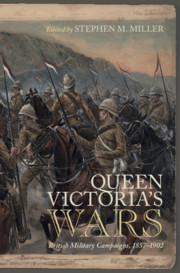Book contents
- Queen Victoria’s Wars
- Queen Victoria’s Wars
- Copyright page
- Contents
- Maps
- Contributors
- Acknowledgements
- 1 Introduction
- 2 The Indian Rebellion, 1857–1858
- 3 Punitive Expeditions in China, 1857–1860
- 4 The Expedition to Abyssinia, 1867–1868
- 5 The New Zealand Wars, 1845–1872
- 6 The Third Anglo-Asante War, 1873–1874
- 7 The Second Afghan War, 1878–1880
- 8 The Anglo-Zulu War, 1879
- 9 The First Anglo-Boer War, 1880–1881
- 10 Egypt and the Sudan, 1881–1885
- 11 The Third Anglo-Burmese War and the Pacification of Burma, 1885–1895
- 12 The Tirah Campaign, 1897–1898
- 13 Reconquest of the Sudan, 1896–1898
- 14 The South African War, 1899–1902
- 15 Conclusion
- Index
- References
2 - The Indian Rebellion, 1857–1858
Published online by Cambridge University Press: 01 June 2021
- Queen Victoria’s Wars
- Queen Victoria’s Wars
- Copyright page
- Contents
- Maps
- Contributors
- Acknowledgements
- 1 Introduction
- 2 The Indian Rebellion, 1857–1858
- 3 Punitive Expeditions in China, 1857–1860
- 4 The Expedition to Abyssinia, 1867–1868
- 5 The New Zealand Wars, 1845–1872
- 6 The Third Anglo-Asante War, 1873–1874
- 7 The Second Afghan War, 1878–1880
- 8 The Anglo-Zulu War, 1879
- 9 The First Anglo-Boer War, 1880–1881
- 10 Egypt and the Sudan, 1881–1885
- 11 The Third Anglo-Burmese War and the Pacification of Burma, 1885–1895
- 12 The Tirah Campaign, 1897–1898
- 13 Reconquest of the Sudan, 1896–1898
- 14 The South African War, 1899–1902
- 15 Conclusion
- Index
- References
Summary
In 1857, a string of military mutinies soon followed by a series of popular uprisings tore apart the core heartland of colonial India and threatened to unravel the British Raj. Units of the Bengal Army rose up against their British officers and in conjunction with other discontented groups quickly seized key cities and towns. The British were ejected from major centres, and there were genuine fears that the conflagration would spread to other regions of colonial India. The scale of the revolt, and the violence with which it was accompanied, was unprecedented. Moreover, the intense racialization of the conflict and the anxieties it spawned, would shape British military, strategic, and political policy throughout the empire for generations to come. Ultimately, the British were able to restore order, but not without a huge amount of bloodshed, in large part because of a lack of common purpose and organization amongst the rebels. The British benefitted from the fact that the revolts did not spread much beyond the north, leaving much of India tense but quiet. Resources could therefore be more easily pooled and concentrated on the rebels who operated bravely but without direction. Militarily, the revolt was a watershed moment for the British Army and for the British Empire.
- Type
- Chapter
- Information
- Queen Victoria's WarsBritish Military Campaigns, 1857–1902, pp. 8 - 39Publisher: Cambridge University PressPrint publication year: 2021
References
Further Reading
- 1
- Cited by

